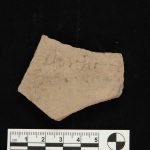| Artefact ID | 1511 |
| TM ID | TM 372096 |
| Findspot (DEChriM ID) | 10 (Amḥayda) | Class | Textual |
| Material | Ceramic |
| Writing medium | Ostracon |
| Text content | Documentary |
| Language | Greek |
| Description | O.Trim. 2 478; O.Amheida inv. 13047: Tag |
| Selection criteria | Christian onomastics |
| Date from | 350 |
| Date to | 370 |
| Dating criteria | Find context; the name Ψενπνούθης figures in multiple other Amḥayda ostraca: O.Trim. 1 16, O.Trim. 1 204, O.Trim. 1 232, O.Trim. 1 239, O.Trim. 1 323, O.Trim. 1 324, O.Trim. 2 502, O.Trim. 2 573, O.Trim. 2 620, and O.Trim. 2 622. It is considered an 'anonymous' theophoric name in scholarship (see Depauw/Clarysse 2013). |
| Absolute/relative date | Relative date |
| Archaeological context | Excavated at Amḥayda by the Dakhleh Oasis Project, season 2008–2013. Discovered in Area 2.1, Room 21, DSU 287, FN 42. |
| Accession number | Egypt, Amheida, American excavations 2008-2013, Inv. 13047 |


 Json data
Json data




